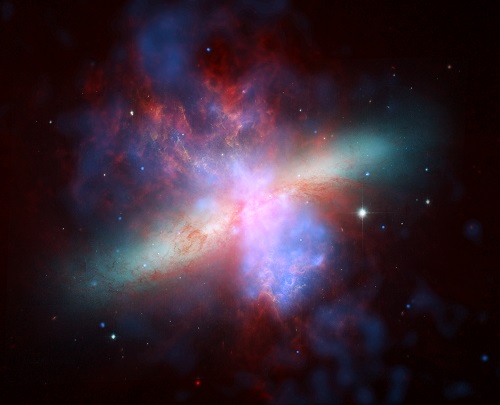Norbert Werner
Associate Professor (Special Appointment), Graduate School of Science
TEL: 082-424-7381 (*For inquiries in English only)
Yasushi Fukazawa
Professor, Graduate School of Science
TEL: 082-424-7380

An international team of researchers has shown that the hot diffuse gas that fills the space between the galaxies has the same concentration of iron in all galaxy clusters that were studied in sufficient detail by the Japanese Suzaku satellite. It seems that most of the iron inside the intergalactic gas arose long before the first clusters of galaxies were formed. The results will be presented this Friday at the annual meeting of the European Astronomical Society, EWASS 2017, in Prague, Czech Republic by Norbert Werner, Leader of the MTA-Eötvös University Lendület “Hot Universe” research group in Hungary and associate professor at the Masaryk University in the Czech Republic and at Hiroshima University in Japan.
The team studied the hot gas permeating ten nearby clusters of galaxies and showed that the concentration of chemical elements is about the same in all of them - a third of that observed in our Sun.
These results confirm earlier indications, which suggested that most of the iron in the Universe was produced and spread throughout intergalactic space before galaxy clusters formed, more than 10 billion years ago. The iron, and many other elements, was blown out of galaxies by the combined energy of billions of supernovae, as well as outbursts from growing supermassive black holes.
Only hydrogen, helium, and trace amounts of lithium were produced during the big bang. Most of the elements that we are made of were forged inside stars and released by stellar explosions called supernovae. How well are the elements spread through the intergalactic space has long been an open question.
“If these elements were produced relatively recently, astronomically speaking, then we would expect a different concentration of iron from cluster to cluster. The fact that the distribution of iron appears so homogeneous, indicates that it has been produced by some of the first stars and galaxies that formed after the big bang,” says Ondrej Urban, the first author of the study who has been a PhD student at Stanford University when he performed the extensive data analysis presented in the study.
“The remarkably uniform distribution of iron also means that the combined energy of many supernovae and the jets and winds of accreting supermassive black holes were able to mix the elements thoroughly across the Universe,” says the corresponding author of the study, Norbert Werner.
The results are accepted for publication in the Monthly Notices of the Royal Astronomical Society.

M82, a nearby galaxy showing strong galactic winds. The early universe must have contained many more galaxies like this, or with even stronger activity. X-ray data (Chandra) appears in blue; infrared light (Spitzer) appears in red; visual data (Hubble telescope) appears in orange and yellow-green. Credit: NASA/JPL-Caltech/STScI/CXC/UofA/ESA/AURA/JHU
Norbert Werner
Associate Professor (Special Appointment), Graduate School of Science
TEL: 082-424-7381 (*For inquiries in English only)
Yasushi Fukazawa
Professor, Graduate School of Science
TEL: 082-424-7380
刊登日期 : 2017/06/30
Copyright © 2003- 广岛大学